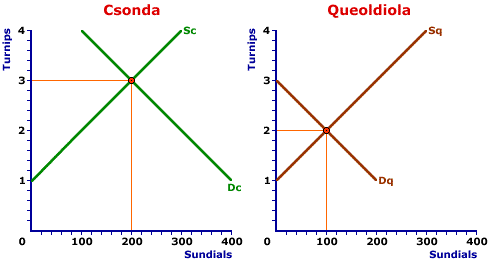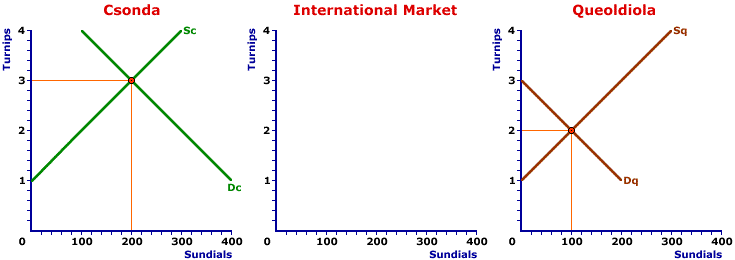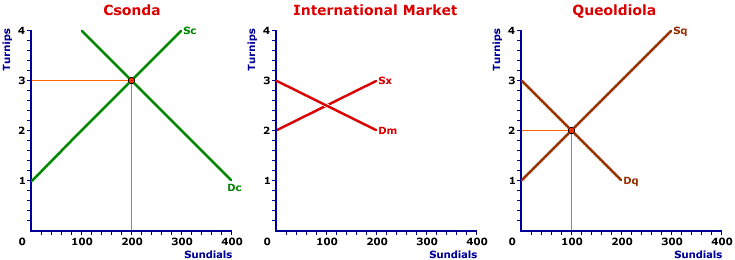The international market is a simple model that is used to analyze how and why two nations are inclined to engage in international trade. It combines the domestic market from one nation, presumably with a relatively high domestic price, with the domestic market from another nation, presumably with a relatively low domestic price.The nation with the higher domestic price contributes the import demand portion of the international market, that is the demand curve. This is the excess demand created as the price falls below its relatively high domestic price. The nation with the lower domestic price contributes the export supply portion of the international market, that is the supply curve. This is the excess supply created as the price rises above its relatively low domestic price.
The international market analysis not only illustrates why and how one nation, with a comparative advantage in the production of a good, trades with another nation, but also the specific quantity traded and the resulting terms of trade, that is the price.
Two Domestic Markets
To develop the international market analysis, consider the hypothetical domestic production of sundials undertaken by two hypothetical countries -- the United Provinces of Csonda and the Republic of Northwest Queoldiola. Northwest Queoldiola has a comparative advantage in the production of sundials.| Two Sundial Markets |  |
The two-panel exhibit to the right illustrates the two domestic markets for sundials in each of these two countries. The left panel represents the internal domestic market conditions for sundials in the United Provinces of Csonda and the right panel illustrates the domestic market for sundials in the Republic of Northwest Queoldiola. At this stage of the analysis, there is no trade between the two nations.Let's take a closer look at each domestic market in each country. But first, note that the horizontal quantity axis of each market diagram measures the number of sundials exchanged and the vertical price axis measures the price in terms of another good that is exchanged for the sundials (in this case turnips). Stating price in terms of the foregone production of another good captures the essence of international trade and comparative advantage.
- Csonda: Working from left to right, the left most panel is the market for sundials in the United Provinces of Csonda. The demand curve for sundials is given by Dc and the supply curve is Sc. Like any market, the intersection of the demand and supply curves is the market equilibrium. This market is in equilibrium at a price of 3 pounds of turnips. While not overly important to the analysis, the quantity exchanged is 200 sundials.
- Queoldiola: Moving to the right, the right most panel is the market for sundials in the Republic of Northwest Queoldiola. The Queoldiolan demand curve for sundials is Dq and the supply curve is Sq. The intersection of these demand and supply curves is once again market equilibrium, which is achieved at a price of 2 pounds of turnips. The quantity exchanged here is 100 sundials.
Ready to Trade
The primary result from this comparison of the two domestic sundial markets is the relative prices. The price of sundials in Csonda is higher than the price in Northwest Queoldiola (3 versus 2 pounds of turnips per sundial). Of course, these prices could be stated in monetary units, either the domestic Northwest Queoldiolan currency (queolds) or the domestic Csondan currency (csonds), but this complication is not needed here.Stating price in terms of turnips, however, does emphasize the relative opportunity cost of production in each country. Whereas Csonda foregoes 3 pounds of turnips to produce each sundial, Northwest Queoldiola foregoes only 2 pounds. Hence Northwest Queoldiola has a comparative advantage in sundial production.
And for this reason, it make sense for Csonda to import sundials from Northwest Queoldiola rather than to produce them domestically.
But how much? And at what price?
To answer these questions we need to derived two curves -- one demand and one supply -- that make up what we can call the international market.
Imports: Excess Demand
| Excess Demand | 
|
Let's first take a close look at the market for sundials in the United Provinces of Csonda. The exhibit presented in the far left panel of the exhibit reproduces the Csondan sundial market. The demand curve for sundials is given by Dc and the supply curve is Sc. The intersection of the two curves is the market equilibrium that generates the domestic price of 3 pounds of turnips.Our immediate concern is how the domestic Csondan market reacts if faced with prices higher or lower than the current domestic market price. While higher is a possibility, we are most interested in lower prices.
Suppose, for example, that the price declines from 3 pounds of turnips to 2 pounds of turnips (which coincidentally is the domestic market price in Northwest Queoldiola). This lower price induces the Csondan buyers to increase their quantity demanded and at the same time it encourages the Csondan sellers to decrease their quantity supplied. The result of both actions is a shortage of sundials. A shortage of 200 sundials. Click the [Shortage] button to reveal this value.
Other prices below 3 pounds of turnips also generate shortages. The lower the price, the bigger the shortage. And of course, a 3 pound price has no shortage.
These alternative shortage values at corresponding prices can be plotted in the center panel of this exhibit. The resulting curve is Csonda's excess demand for sundials. It indicates the sundials that Csonda would be willing to import at different prices. Click the [Import Demand] button to reveal this import demand curve.
Exports: Excess Supply
| Excess Supply | 
|
Let's now turn to the market for sundials in the Republic of Northwest Queoldiola. The exhibit presented in the far right panel of the exhibit reproduces the Queoldiolan sundial market. The demand curve for sundials is given by Dq and the supply curve is Sq. The intersection of the two curves is once again the market equilibrium that in this case generates the domestic price of 2 pounds of turnips.Our concern now is how the domestic Queoldiolan market reacts if faced with prices higher or lower than the current domestic market price. While lower is a possibility, we are more interested in higher prices.
Suppose, for example, that the price increases from 2 pounds of turnips to 3 pounds of turnips (which coincidentally is the domestic market price in Csonda). This higher price induces the Queoldiolan buyers to decrease their quantity demanded and at the same time it encourages the Csondan sellers to increase their quantity supplied. The result of both actions is a surplus of sundials. A surplus of 200 sundials. Click the [Surplus] button to highlight this value.
Other prices above 2 pounds of turnips also generate surpluses. The higher the price, the bigger the surplus. And of course, a 2 pound price has no surplus.
These alternative surplus values at corresponding prices can be plotted in the center panel of this exhibit. The resulting curve is Northwest Queoldiola's excess supply of sundials. It indicates the sundials that Northwest Queoldiola would be willing to export at different prices. Click the [Export Supply] button to reveal this export supply curve.
The International Market
| The International Market | 
|
The derivation of the import demand curve from Csonda and the export supply curve from Northwest Queoldiola sets the stage to identify the quantity of sundials traded between these two nations and the price paid. Click the [International Market] button to reveal both curves.However, before answering these questions make note of the analytical model being used. This international market analysis is extremely powerful and flexible.
- More Countries: The import demand curve and the export supply curve can be easily expanded to included other countries. In the same way that a standard market demand curve is derived by adding the demands for several buyers, an import demand curve can be derived by identifying the shortages for a number of countries. The same applies to the export supply curve, as well. The ensuing analysis is essentially unchanged with more than one country on each side of the market.
- Domestic Shocks: Because this analysis is based on the domestic market conditions for each country, disruptions to those markets are transferred to the international market. If, for example, the domestic demand in an importing country increases, then the import demand curve also increases. Or if the domestic supply in an exporting country decreases, then the export demand curve also decreases.
Equilibrium Trade
| Making the Trade | 
|
The import demand curve and export supply curve can be used to answer the questions: "How much?" and "What price?" We're relatively certain that the United Provinces of Csonda will import sundials from the Republic of Northwest Queoldiola based on the analysis of comparative advantage. But we have yet to identify how many sundials will be traded and the price paid for the exchange.This deficiency in the analysis can be rectified with the exhibit to the right.The far left panel is once again the domestic market for sundials in the Csonda. The far right panel is the domestic sundial market in Northwest Queoldiola. The domestic Csondan sundial price is 3 pounds of turnips and the domestic Northwest Queoldiolan price is 2 pounds of turnips.
The center panel then presents the import demand curve, Dm, and the export supply curve, Sx, that make up the international market. The import demand curve is based on the shortage of sundials that arises in Csonda for prices below 3 pounds of turnips. The export supply curve is based on the surplus of sundials that arises in Northwest Queoldiola for prices above 2 pounds of turnips.
Like any market, equilibrium in this international sundial market is achieved by the intersection of the demand and supply curves. This intersection occurs at a price of 2.5 pounds of turnips and a quantity of 100 sundials. Click the [Equilibrium] button to highlight this result. The implication of this equilibrium is that Csonda imports 100 sundials from Northwest Queoldiola, paying a price of 2.5 pounds of turnips each. (Actually this means that Northwest Queoldiola sends 100 sundials to Csonda and in return Csonda sends 250 pounds of turnips to Northwest Queoldiola.)
We can identify the import and export quantities in the respective domestic markets by tracing the 2.5 pound price back to each market. To highlight the 100 sundials imported by Csonda, click the [Import] button. To highlight the 100 sundials exported by Northwest Queoldiola, click the [Export] button. Of course, both values are identical because the international market is in equilibrium balance.
Winners and Losers
An important implication of this analysis is noting who wins and who loses in each of the countries. - Csonda: First, consider the United Provinces of Csonda. With foreign trade, the price of sundials declines from 3 pounds of turnips to 2.5 pounds and the quantity of sundials consumed increases from 200 to 275. This is clearly beneficial to the Csonda sundial consumers. They have an increase in the quantity consumed and pay a lower price for each sundial. What more could they want? Unfortunately, the story is not as rosy for the domestic Csondan sundial producers. They had been receiving 3 pounds of turnips for each sundial sold, now they receive only 2.5 pounds. Moreover, they were selling 200 sundials, but with the 100 sundials imported from Northwest Queoldiola, their production declines to 175 sundials. They produce less and receive a lower price, not a recipe for greater profits.
- Northwest Queoldiola: Now let's turn our attention to the Republic of Northwest Queoldiola. With foreign trade, the price of sundials rises from 2 pounds of turnips to 2.5 pounds and the quantity of sundials produced increases from 100 to 150. This is clearly beneficial to the Northwest Queoldiolan sundial producers. They have an increase in the quantity produced and receive a higher price for each sundial. What more could they want? Unfortunately, the story is not as rosy for the domestic Northwest Queoldiolan sundial consumers. They had been paying 2 pounds of turnips for each sundial bought, now they pay on 2.5 pounds. Moreover, they were buying 100 sundials, but with the 100 sundials exported to Csonda, their consumption declines to 50 sundials. They consume less and pay a higher price, not something that enhances their satisfaction.
INTERNATIONAL MARKET, AmosWEB Encyclonomic WEB*pedia, http://www.AmosWEB.com, AmosWEB LLC, 2000-2025. [Accessed: July 18, 2025].


